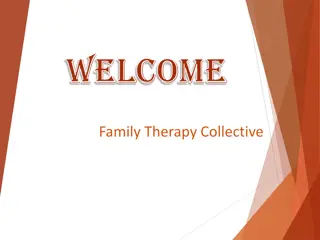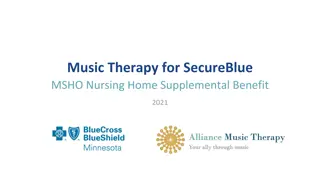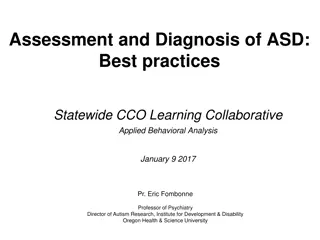Investigating the Impact of Music Therapy on Brain Connectivity in Children with ASD
Autism Spectrum Disorder (ASD) presents challenges in social communication and behavior, but music therapy has shown promise in enhancing social skills and communication. This study aims to explore the effects of music-based interventions on brain connectivity in children with ASD through a randomized controlled trial. By comparing music therapy with a non-music control intervention, researchers seek to determine the potential benefits for social communication, family quality of life, and functional brain connectivity in school-age children with ASD.
Download Presentation

Please find below an Image/Link to download the presentation.
The content on the website is provided AS IS for your information and personal use only. It may not be sold, licensed, or shared on other websites without obtaining consent from the author. Download presentation by click this link. If you encounter any issues during the download, it is possible that the publisher has removed the file from their server.
E N D
Presentation Transcript
Autism Spectrum Disorder (ASD) is a neurodevelopmental condition characterized by social communication difficulties and restricted and repetitive behaviours as well as strengths in varied domains. ASD is highly prevalent but there is a wide range in symptoms, clinical presentation and underlying brain connectivity. Consequently, a variety of behavioural and psychosocial treatments are sought by families. This has led to investigations of alternate and creative means of expression such as music that might improve social communication, increasing prospects for meaningful relationships. Previous randomized controlled trials (RCTs) of music interventions for ASD have reported positive effects of music on emotional engagement, social interaction, communication and parent child relationships. Many studies have reported intact or enhanced musical skills such as absolute pitch, enhanced melodic memory and contour-processing in children with ASD. ASD children have shown greater brain responses to song versus speech in fronto-temporal brain regions and intact emotional responsiveness to music. Reports from parents and caregivers have described the profound effects music has had on children with ASD. Neuroimaging studies have shown that participating in musical activities engages a network of brain regions involved in hearing, movement, emotion, pleasure and memory. However, a direct link between effects of music interventions and changes in the brain is yet to be demonstrated in autism. Our aim in the current experiment was to establish direct links beween music therapy and brain changes.
Altered intrinsic brain connectivity is a hallmark of ASD. Both over-connectivity and under-connectivity have been reported, in particular, under-connectivity of fronto-temporal and cortico-subcortical networks and over-connectivity of sensory networks. Resting-state functional magnetic resonance imaging (rsfMRI) allows measurement of intrinsic brain connectivity and has been recommended as an outcome measure for intervention studies since it affords the advantage of being task-independent, has high test retest reliability, limited practice effects and can provide reliable estimates of functional brain connectivity corresponding to underlying anatomy. Currently, evidence for effectiveness of music interventions is limited and there is no neuroscientific basis for its use in ASD. However, given the impact of music on social functioning and brain connectivity, alongside differences in these areas in ASD, music-based activities may restore altered brain connectivity and social difficulties in ASD. Our goal was to investigate whether music-based interventions can indeed alter rsfMRI signals, leading to improved functioning in ASD. The specific aim of this RCT was to investigate whether 8 12 weeks of a music-based intervention (compared to a non- music control intervention) can improve social communication, family quality of life (FQoL) and functional brain connectivity in school-age children with ASD.
Method: Fifty children aged 612 years who were diagnosed with ASD were randomly allocated to a music therapy group (N = 25) or an active control group. Both interventions involved 45-minute individual weekly sessions conducted over 8 12 weeks by the same therapist. MT made use of musical instruments, songs and rhythmic cues while targeting communication, turn-taking, sensorimotor integration, social appropriateness and musical interaction. The active control group involved play-based intervention to control for non-specific factors, such as positive treatment expectancies, intervention support, therapist attention and emotional engagement. Both interventions were conducted in the same setting and targeted common goal such as verbal and social communication, multisensory integration and emotional regulation. The primary difference was the use of music as a central component in the music therapy group
Behavioural Outcomes: Improvements in social communication from baseline to post-intervention were evident in the music therapy compared to the control group. No music therapy specific improvements were found on social responsiveness or receptive vocabulary. We also found a positive effect of music therapy on and both groups showed reduced maladaptive behaviours.
Brain Connectivity Outcomes. Music therapy increased functional connectivity between primary auditory cortex and subcortical and motor regions and reduced over- connectivity between auditory and visual-association areas. Importantly, changes in brain connectivity were related to improvements in children s communication skills after music therapy. Implications: The present study demonstrates that 8 12 weeks of music intervention (relative to non-music behavioural intervention) can improve parent-reported social communication, as well as improvements in family interaction, cohesion and coping. These changes were also reflected in changes in intrinsic brain connectivity. The outcomes support the use of music as a therapeutic tool for individuals with ASD.























